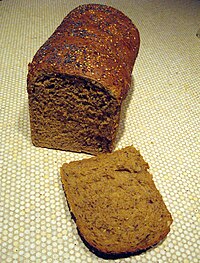
Photo from wikipedia
Sodium overconsumption has become a serious health concern resulting in the Food and Drug Administration (FDA) publishing voluntary sodium reduction guidelines for a wide spectrum of packaged and processed foods.… Click to show full abstract
Sodium overconsumption has become a serious health concern resulting in the Food and Drug Administration (FDA) publishing voluntary sodium reduction guidelines for a wide spectrum of packaged and processed foods. Reducing sodium through the removal of salt may decrease the palatability of foods, thus increasing the need for new approaches to prevent such palatability loss. The objective of this research was to characterize white and multigrain breads with either 43% or 60% reduction in sodium and with and without monosodium glutamate (MSG) using descriptive analysis methodology as well as to identify the drivers of liking for white and multigrain breads of varying sodium contents with and without MSG. Significant differences were identified in the attributes of salty taste and aftertaste, savory aftertaste, and chewy and firm textures in white bread and of salty taste and aftertaste, sweet taste, and density in multigrain bread. By regressing consumer test data of these breads onto their principal component analysis biplots, textural attributes and salty taste and aftertaste were identified as primary drivers of liking in white and multigrain breads. Flavor enhancers such as MSG show promise in mitigating palatability loss that occurs when the sodium content of bread is greatly reduced and thus provide a promising solution to produce breads with an improved nutritional profile. Future research on flavor enhancement in other food matrices would be valuable as well as in other bread and carbohydrate-based food categories. PRACTICAL APPLICATION: The findings of our study suggest that texture and a salty taste and aftertaste drive consumer liking of reduced-sodium white and multigrain breads and liking of breads could be improved with the addition of monosodium glutamate. Increasing the acceptance of reduced-sodium food products could help to improve the health of the American population by resulting in a reduced risk of hypertension and subsequently heart attacks and stroke.
Journal Title: Journal of food science
Year Published: 2023
Link to full text (if available)
Share on Social Media: Sign Up to like & get
recommendations!